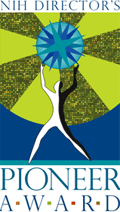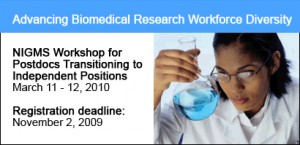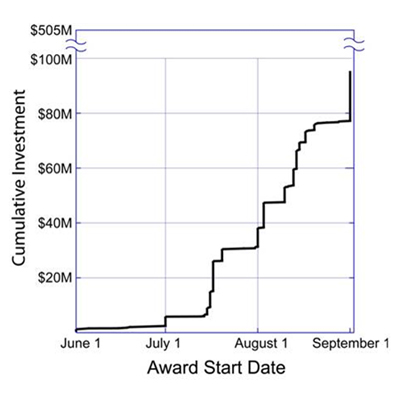We’ve modified the receipt dates for our administrative supplement program Supplements for Collaborative Science (SCS), which helps grantees form new collaborations that enhance their NIGMS-funded research efforts. There will be only two submission deadlines in 2010: January 15 and May 15. All other details of the program remain the same. If you’re a grantee interested in applying for an SCS supplement, please read the entire NIH Guide notice and contact your program director to discuss your plans.
Year: 2009
A New Frontier for Therapeutics: Integrating Pharmacology and Systems Biology
Over the years, we have learned that drugs act in very complex ways and cause a combination of wanted and unwanted effects, many—if not most—of which are still poorly understood. Attaining a deeper knowledge of how drugs act in the body and their connections to therapeutic and toxicological outcomes now requires a systems-level approach.
At this time, NIGMS has a substantial grant investment in pharmacology and in systems biology, but we have not seen a great deal of activity integrating pharmacology with systems biology to benefit drug discovery and the understanding of drug action.

With this in mind, NIGMS hosted the first Quantitative and Systems Pharmacology Workshop last September. We brought together researchers from systems biology, pharmacology and pharmacokinetic/pharmacodynamic modeling to figure out how these fields can come together to advance drug design and discovery. The group addressed the topic from the standpoint of both horizontal integration (various networks in various cell systems) and vertical integration (connections between pathways at different levels of organization, tissues, organs, etc.). You can read the workshop report for a summary of the discussions.
An important outcome from the meeting was the feedback we got from participants about how far apart their disciplines presently are yet how much they have in common. The participants encouraged us to create more opportunities for them to interact and help bridge their disciplines.
To help promote and facilitate these interactions, we are now planning our second Quantitative and Systems Pharmacology meeting for fall 2010. We want your input to help shape the program. What do you think are the cutting-edge topics? What are the biggest challenges? What advances are needed to develop a systems approach to therapeutics?
You can comment here, or send an e-mail to me or any of the other meeting organizers. They include Sarah Dunsmore, Richard Okita and Peter Lyster from NIGMS and Grace Peng from the National Institute of Biomedical Imaging and Bioengineering.
Happy Fifth Birthday, MIDAS
Five years ago this summer, MIDAS, the Models of Infectious Disease Agent Study, was born. When we began, we knew the effort to develop computational models of disease spread would play a role in preparing for new outbreaks—we just didn’t think it’d be so immediate. First with H5N1 fears and now with the H1N1 pandemic, our researchers have provided computational models to help decisionmakers from all levels of the government plan ways to control flu.
While modeling is just one of many tools used in making policy recommendations, it can help explore different scenarios and outcomes. In the case of flu, MIDAS scientists have used their models to help answer questions like:
- Can you contain a pandemic locally?
- What’s the best way to slow the spread of flu while we develop a vaccine?
- What’s the impact of non-pharmaceutical interventions?
- Should we distribute antivirals before an outbreak?
As we head into the next five years, we are adding two new centers and three research groups that are pretty exciting. They bring expertise in such areas as MRSA modeling, high-performance computing, statistics, social behavior and visualization tools for non-experts. We’re also going to put a lot more effort into understanding the ecology and evolution of disease, the impact of co-infections, and antibiotic and antiviral resistance.
The two new centers have an additional charge in education and outreach, particularly with public health officials from around the world. I am especially looking forward to this, since there’s such a great need for people with backgrounds in infectious disease epidemiology to also be able to do analytical and computational work.
The thoughtful, careful studies we do through MIDAS require a diverse group of people to communicate with each other every day. One thing I love about the way MIDAS has matured over the years is that we’ve built a level of trust and collaboration. Our researchers freely share data, ideas, and analytical and computational tools.
As we’ve learned, health policy questions emerge and develop almost instantly as new issues arise. Our challenge will continue to be modeling in this real-time context.
Got a Progress Report Due on October 15?
 NIH recently announced policy changes for progress reports (aka PHS 2590 and noncompeting continuation). These will take effect on October 1, and corresponding changes to the eSNAP Commons Module will follow on October 9.
NIH recently announced policy changes for progress reports (aka PHS 2590 and noncompeting continuation). These will take effect on October 1, and corresponding changes to the eSNAP Commons Module will follow on October 9.
The biggest change for most NIGMS grantees is the replacement of the Senior/Key Personnel Report with an All Personnel Report (Form page 7) that collects information on all personnel who participate in the project for at least one person month. The All Personnel Report also implements a new NIH requirement that all individuals with a postdoctoral role with one person month or more of measurable effort must have an eRA Commons user ID.
Other progress report changes address the use of human embryonic stem cells, revisions related to the NIH Enhancing Peer Review initiative, and data required for institutional training awards that support graduate students.
Revised instructions and forms are available at http://grants.nih.gov/grants/forms.htm.
Inquires about preparing a specific progress report should be directed to your program official and/or grants management specialist.
Apply Now for Microbe-Host Interactions Grants
Back in May, I described a concept clearance for a new grant program focused on microbe-host interactions. A number of readers commented on the post, and I was delighted to see the early interest in this new program, as well as other related programs at NIH.
The RFA has now been published in the NIH Guide.
We’re soliciting applications for projects that will reveal the basic principles and mechanisms that govern host-associated microbial community structure and function through studies in the following areas: model systems, community physiology, community genetic interactions, community dynamics, and technology development. Please note that research projects designed solely to carry out metagenomic sequencing or surveys of microbial diversity are outside the scope of this program.
We plan to make 5-6 R01 awards totaling $2.5 million in fiscal year 2010. Letters of intent are due December 15, 2009, and applications are due by January 15, 2010.
Now Seeking Applications for Next Year’s “Pioneers” and “New Innovators”
 NIH has announced the 2010 competitions for the NIH Director’s Pioneer Awards and the NIH Director’s New Innovator Awards. These awards support exceptionally creative scientists who propose highly innovative—and often unconventional—approaches to major challenges in biomedical or behavioral research. Both programs are part of the NIH Roadmap for Medical Research and are managed by NIGMS.
NIH has announced the 2010 competitions for the NIH Director’s Pioneer Awards and the NIH Director’s New Innovator Awards. These awards support exceptionally creative scientists who propose highly innovative—and often unconventional—approaches to major challenges in biomedical or behavioral research. Both programs are part of the NIH Roadmap for Medical Research and are managed by NIGMS.
The Pioneer Award provides $2.5 million in direct costs over five years and is open to scientists at U.S. institutions at any career level. The deadline for applying is October 20, 2009.
 The New Innovator Award provides $1.5 million in direct costs over five years and is designed for early stage investigators at U.S. institutions who have not yet obtained an NIH R01 or similar grant. Applications are due by October 27, 2009.
The New Innovator Award provides $1.5 million in direct costs over five years and is designed for early stage investigators at U.S. institutions who have not yet obtained an NIH R01 or similar grant. Applications are due by October 27, 2009.
For more information about the programs and links to the requests for applications, see the Pioneer Award Web site and the New Innovator Award Web site.
One of the features of these programs that I find most exciting is the annual symposium. This year’s symposium will take place on the NIH campus in Bethesda on September 24 and 25 and will include research talks by the first graduating class of Pioneer Award recipients and by the class of 2008. The 2009 award recipients will also be announced. The symposium will be videocast live and archived at http://videocast.nih.gov.
Important Updates about the PSI:Biology Funding Opportunities
 Since my last post about PSI:Biology, I’ve received lots of questions about the initiative and the new funding opportunities. To answer these questions more broadly and encourage more applicants, we’re hosting a live videocast briefing on Monday, August 31, from 2:30 to 4:30 p.m. EDT. You’ll hear from Jeremy Berg, Cathy Lewis and myself.
Since my last post about PSI:Biology, I’ve received lots of questions about the initiative and the new funding opportunities. To answer these questions more broadly and encourage more applicants, we’re hosting a live videocast briefing on Monday, August 31, from 2:30 to 4:30 p.m. EDT. You’ll hear from Jeremy Berg, Cathy Lewis and myself.
Participants will have the chance to ask questions, make comments, get input on possible research projects and identify potential collaborators. You can use the live event feedback form on the videocast page, or you can send your questions in advance by e-mailing me or posting a comment here. If you would like to remain anonymous, please be sure to let us know so we don’t share your name during the briefing.

To watch the live event, go to http://videocast.nih.gov next Monday and look for “PSI: Biology VideoCast Briefing” in the “Today’s Events” section. Later, you’ll be able to find the archived version of the briefing on the past events page.
A number of you have wondered if NIGMS can help you identify other researchers with whom you might collaborate to develop an application to establish one of the PSI:Biology partnerships. In response, we’ve established a Web form that will allow you to enter your name and contact information and a brief description of the research area for which you would like to apply. Participation is entirely up to you and is not a requirement for application. The form and the public page with submissions will be posted until the application deadline.
This brings me to my final update: We have extended the due dates for submitting letters of intent and applications. They are now September 28, 2009, and October 28, 2009, respectively.
UPDATE: We just issued an NIH Guide notice that includes some additional information.


 The workshop is called “Advancing Biomedical Research Workforce Diversity: NIGMS Workshop for Postdocs Transitioning to Independent Positions.”
The workshop is called “Advancing Biomedical Research Workforce Diversity: NIGMS Workshop for Postdocs Transitioning to Independent Positions.”
